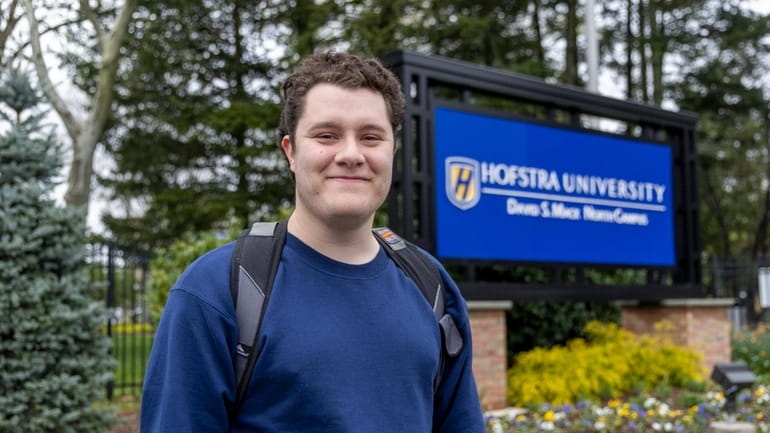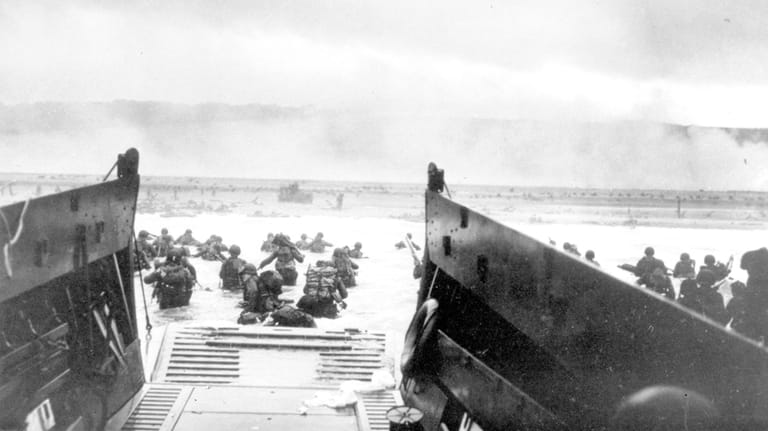Hofstra University senior's D-Day essay earns him Normandy trip to mark 80 years since invasion

Hofstra University senior Dominick Pursino's winning essay, intertwining the 1944 D-Day invasion’s military significance with his family history, earned him a trip in June to Normandy, France for the 80th anniversary of the allied assault. Credit: Howard Schnapp
A Hofstra University senior has won the Museum of American Armor’s D-Day essay contest. His prize is a professionally guided tour that will put him on the beaches of Normandy, France, on June 6, the 80th anniversary of the largest amphibious invasion in history.
Dominick Pursino, 22, of Commack, wrote an essay that intertwined the invasion’s military significance with his family history. Pursino's connection was indirect but powerful: His late grandmother had lived under Nazi occupation in Italy during World War II and heard about the Allied operation on the radio.
From her, Pursino wrote, he heard stories about the “synchronous stomping of the German troops in formation,” forced labor and severe punishments, and later, the chocolate handed out by American troops.
Had D-Day failed, he wrote, so might have the Allied war effort. His grandmother might never have immigrated to Brooklyn and suburban Long Island. Were it not for the soldiers on Normandy’s beaches, he wrote, “my existence on this planet would be extremely unlikely.”
Pursino, an education major who hopes to teach middle school social studies and special education, said in an interview that his grandmother, Christina D’Agostino — who died several years ago at 92 — was in her teens in 1941 when the Nazis appeared in her small hometown of Giovinazzo. They left in 1943. Pursino said D’Agostino was a professional artist who settled in Kings Park.

U.S troops wade ashore at Normandy, France on D-Day, June 6, 1944. Credit: AP
He said he’d listened avidly to his grandmother’s stories about life under occupation: the strict rules, the curfews, the neighbors who sometimes disappeared. D-Day, when the Allies used 7,000 vessels to land 133,000 troops, of which more than 10,000 were either killed or wounded, is now considered a watershed moment in the war. But as it unfolded for Pursino’s grandmother, “it took a while for it to be deemed successful,” he recalled.
Leading up to his June Normandy trip, Pursino said he plans to read up on the history of World War II. His 10-day adventure will start in London “in the war rooms where they planned the whole campaign.” A ferry ride over the channel waters crossed by the troops will follow, then on to the beaches where the troops landed.
But it's the stories his grandmother told to him of her life and how the invasion changed it that Pursino hopes to one day tell his students.
“In history, you always learn about the big names, and there’s nothing wrong with that. But sometimes there are more interesting personal stories that can be taken from those who didn’t get representation in textbooks,” he said.
In an interview, Gary Lewi, a museum board member and one of the contest judges, said Pursino’s essay was chosen from roughly 100 entries. It “put together, in a very cogent way, the sacrifice of thousands of GIs on the beach and the liberation of a continent from a terror that is still unimaginable,” Lewi said. “It wasn’t just a recitation of statistics, how many ships, how many men, but the human dimension of what that sacrifice on June 6 meant to humanity.”
While Pursino is in Europe, the museum will commemorate D-Day with a ceremony at its Old Bethpage grounds, Lewi said. Scheduled to attend are British and French diplomats, military veterans, along with Nassau County Executive Bruce Blakeman and Suffolk County Executive Ed Romaine.
The ceremony will honor two Long Islanders killed in the invasion, Charles T. Byrnes and Sidney Dudgeon, Lewi said.
